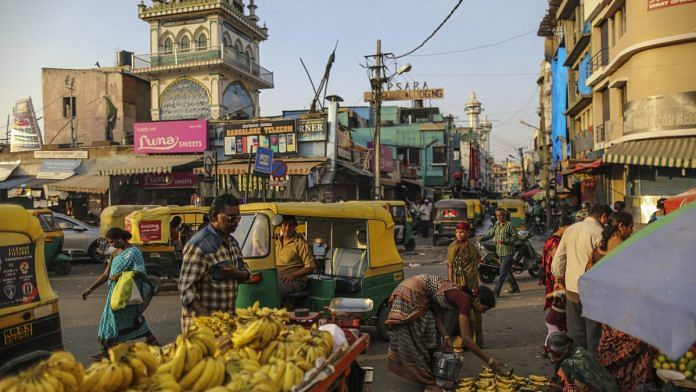Mumbai: India’s slowdown and a simmering shadow banking crisis is putting Prime Minister Narendra Modi’s goal of crafting a $5 trillion economy by 2025 at risk.
The nation entered 2019 as the world’s sixth-biggest economy poised to become the fifth. Instead, it has slipped a notch to seventh place as a collapse in consumption slowed gross domestic product growth to the weakest in six years. External shocks from trade wars to surging oil prices are exacerbating that pain.
Troubled by the grim prospects, the central bank has lowered interest rates to a nine-year low and Governor Shaktikanta Das wants other stakeholders — from the government to banks to the private sector — to step up. But with Finance Minister Nirmala Sitharaman facing lower revenue prospects that threaten her budget gap goal, the heavy lifting on stimulus appears to lie with the Reserve Bank of India.
Das may be able to ease a financing squeeze, but it’ll take delivery on big bang reforms to unlock the productivity gains needed to power the economy toward Modi’s goals. While his return to office this year with a bigger mandate stoked expectations among investors for bolder reforms, that hope is fading 100 days into his second term as global investors head for the exit.
Unemployment at a 45-year high has hurt demand for everything from soaps to 7-cent cookies, while car sales have slumped the most on record and new investments have been sluggish as a lingering shadow banking crisis curbs lending. That’s caused growth to decelerate for five straight quarters to 5% in the three months to June — the weakest since March 2013 — and well below the 8% plus annual expansion needed to achieve the goal.
What Bloomberg’s Economists Say
“We expect the first-term reforms of the Modi government, including a clean-up of the banking sector, a new bankruptcy law, and a new indirect tax structure, to mark a transition to a faster-growth trajectory. These should lift potential growth to 8% from around 7.4% now. At the same time, we expect a recovery in actual growth, picking up from an estimated 6.2% in fiscal 2020 to 8.5% in fiscal 2025.”
— Abhishek Gupta, India economist
“For the economy to reach $5 trillion, it will take the types of reform that were long promised: massive reductions in regulations, streamlining of labor laws, privatization of state entities, investments in infrastructure,” said Vivek Wadhwa, a distinguished fellow and professor at Carnegie Mellon University’s College of Engineering at Silicon Valley. “Yet little happened,” he said.
That laundry list needs to be implemented quickly as India, according to most economists, faces a structural as well as a cyclical slowdown. New measures announced so far by the government to bolster growth are seen falling short of addressing the pain points.
Underpinning the target of $5 trillion is the government’s forecast of 8% average GDP growth, according to Shilan Shah, senior India economist with Capital Economics in Singapore. “That is setting a very high bar,” he said.
Oil Prices
Volatile oil prices following the attack on an oil facility in Saudi Arabia are an added risk to the economy that imports 80% of its crude oil needs, while slowing global growth spawned by trade tensions have subdued demand for its exports.
“There is clearly a demand recession going on right now,” said Girija Pande, chairman of Singapore-based Apex Avalon Consulting Pte. and a former CEO of Tata Consultancy Services Ltd. “One has to boost aggregate demand and one of the ways of doing that is by lowering rates.”
Another way is by attracting large dollops of foreign investments into fresh projects and be part of trading blocs like the Regional Comprehensive Economic Partnership. While India has jumped in the ease of doing business rankings, it has not been enough to attract significant foreign capital to become part of global supply chains despite some initial hopes that businesses might relocate to shield themselves from the ongoing U.S.-China trade war.
While Modi has seen through far-reaching reforms — giving RBI an inflation targeting mandate, introducing a nationwide consumption tax and passing an insolvency law — in his first term, he’s fallen short of overhauling the banking system. Besides, large parts of the economy are yet to recover from his decision to ban high-value bills in 2016.
“Investors should await clarity in the coming months on what steps the government will take to ease labor laws, reform the banking system and privatize state-owned enterprises,” said Amitabh Dubey, an analyst at TS Lombard.
“But at the same time they should be prepared for a continuation of past policies: namely, a mix of reform, state control and populism.” – Bloomberg
Also read: Is sinking Indian economy beginning to chip away Modi’s larger-than-life image?







Prime Minister Modi’s goal of making India a $5 trillion economy by 2024-25 is achievable, if it is directly owned, governed and monitored by PMO under a dedicated Advisor “Mission $5Trn Economy”. This transformation does not simply happen, it requires an overall integrated development strategy and detailed planning, with the host of supporting mechanism including public private partnerships, institutional reforms, training and public education, infrastructure & technology, finance and credit systems that reach to the poor, continued monitoring & evaluation.
Chamber for international Trade and industry (CITI) would be happy to discuss the strategy with Hon’ble Prime Minister and offer a roadmap and action plan for making India a $5trn economy by 2024-25 .
Not really.As per todays front page Modi’s go for Dr Subramanian swamy has published a book (Reset) that 5T economy is a impossible claim since DDP has to grow at 14.5$ and it is impossible. It is ironic Modi has nor dared to say it is nominal or current peice either as .a escaoe route
Anybody remember Indira Gandhi’s “garbi hatao” slogan? That’s exactly how Modi’s 5T will be remembered in future.